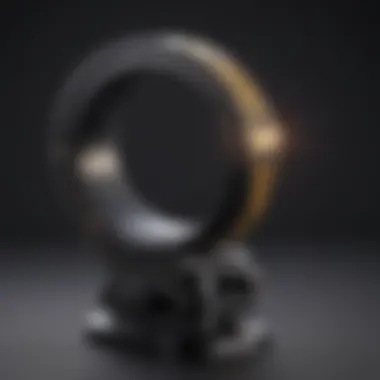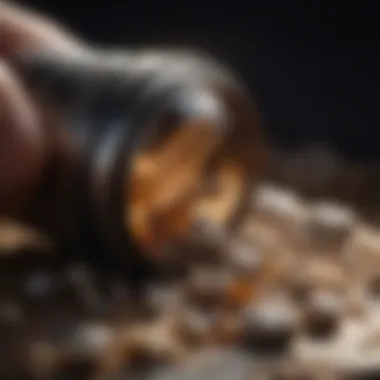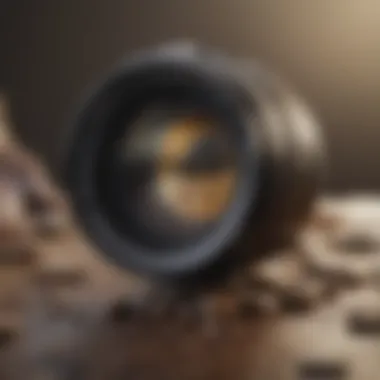Unveiling the Intricacies of Jewelers' Scopes for Rock and Fossil Collectors


Rock and Fossil Identification
In the vast realm of rock and fossil collection, the first step towards understanding and appreciating these geological wonders lies in identification. Rocks and fossils come in an array of types, each bearing unique characteristics that facilitate categorization and study. From sedimentary to igneous rocks, and from trace fossils to body fossils, the diversity in composition and formation is a testament to Earth's profound history encapsulated within these specimens. As aspiring collectors delve into this world, honing the ability to differentiate between various rock and fossil types becomes an indispensable skill. Utilizing tools such as jeweler's scopes to scrutinize the intricate details and textures can greatly aid in discerning key features that distinguish one specimen from another.
Types of rocks and fossils ascertain varying attributes and structural patterns. Sedimentary rocks, formed through the accumulation and solidification of sediments over time, exhibit stratified layers that offer insight into past environments and climates. In contrast, igneous rocks, originating from molten magma that cools and solidifies beneath or above Earth's surface, display a crystalline structure indicative of rapid or gradual cooling processes. When it comes to fossil identification, the distinction between trace fossils, such as footprints or burrows, and body fossils, encompassing the preserved remains of organisms, enables collectors to navigate the rich tapestry of prehistoric life with precision and clarity.
The characteristics to look for in rocks and fossils extend beyond basic visual observations. Texture, color, hardness, and mineral composition serve as foundational clues that unveil the geological story encapsulated within each specimen. For instance, the presence of specific minerals like quartz, feldspar, or calcite can provide valuable hints about the type of rock or fossil, aiding collectors in their classification endeavors. By honing their observational skills and familiarizing themselves with these distinguishing features, enthusiasts can embark on a journey of discovery, unraveling the mysteries embedded within Earth's geological bounty.
Introduction to Jewelers' Scope
Understanding Jewelers' Scope
Definition and Function
Diving into the intricacies of the definition and function of jewelers' scopes sheds light on their indispensable nature in the world of exploration. A jewelers' scope serves as a powerful tool that offers magnification capabilities, enabling collectors to observe specimens with exceptional clarity and precision. The unique feature of adjustable magnification levels allows for versatile use across a wide range of specimens, making it a popular choice among collectors who value detailed examination.
Magnification Levels
The magnification levels of jewelers' scopes play a crucial role in enhancing the collector's ability to perceive fine details. By providing varying levels of magnification, these scopes offer a closer look at the intricate features of specimens, making it easier to uncover hidden complexities. This feature proves advantageous in revealing the true essence of rocks and fossils, allowing collectors to appreciate the nuances that may go unnoticed with the naked eye.
Benefits of Using a Scope
Utilizing a jewelers' scope brings forth a multitude of benefits for collectors embarking on a journey of exploration. The exceptional magnification offered by these scopes enables collectors to delve deep into the structure of specimens, unveiling intricate patterns and textures that enrich the viewing experience. Additionally, the enhanced clarity and precision provided by the scope contribute to accurate observations, fostering a deeper understanding and appreciation of the unique characteristics present in each specimen.
Importance of Precision in Examination
Precision in examination holds immense significance for collectors aiming to unravel the mysteries encapsulated within rocks and fossils. The ability to detect fine details, identify geological features, and evaluate specimen quality serves as the cornerstone of meticulous examination, allowing collectors to gain profound insights into their cherished specimens.
Detecting Fine Details
The capability to detect fine details through jewelers' scopes empowers collectors to uncover subtle nuances that may elude the naked eye. By magnifying minute features, collectors can explore the intricate textures and patterns present in specimens, enhancing their understanding and appreciation of the specimen's uniqueness.
Identifying Geological Features
Identification of geological features plays a pivotal role in deciphering the origin and composition of specimens under examination. Jewelers' scopes enable collectors to distinguish key geological characteristics, such as crystal formations and mineral patterns, aiding in the classification and categorization of rocks and fossils with precision and accuracy.
Evaluating Specimen Quality
The ability to evaluate specimen quality through jewelers' scopes allows collectors to assess the condition and authenticity of their precious finds. By scrutinizing the details and imperfections visible under magnification, collectors can make informed decisions regarding the value and significance of each specimen, ensuring a curated collection of high-quality rocks and fossils.
Types of Jewelers' Scopes
Handheld Magnifiers
In the intricate domain of rock and fossil collecting, handheld magnifiers play a pivotal role in magnifying specimens for detailed examination. The features and applications of handheld magnifiers contribute significantly to the overall objective of scrutinizing specimens with precision and clarity. Their compact design and portability make them a convenient choice for collectors who prioritize flexibility and ease of use in their examining process.


Features and Applications
Handheld magnifiers boast a user-friendly design, allowing collectors to zoom in on intricate details of specimens effortlessly. The key characteristic of handheld magnifiers lies in their adjustable magnification levels, enabling users to focus on specific elements of a specimen with enhanced clarity. This feature is particularly beneficial for collectors aiming to scrutinize microcrystals, fossil structures, or surface textures with utmost accuracy.
Pros and Cons
Despite their portability and ease of use, handheld magnifiers are limited by their lower magnification capabilities compared to other types of scopes. While they excel in examining small details up close, they may lack the power required for viewing specimens at higher magnification levels. This limitation can impact the thoroughness of examinations, especially when analyzing extremely minute features that demand higher magnification.
Desktop Microscopes
The realm of rock and fossil examination also embraces desktop microscopes, offering collectors a different perspective through high-powered viewing and digital imaging capabilities. Desktop microscopes provide an unparalleled level of magnification, allowing collectors to explore specimens in intricate detail. Their digital imaging capabilities further enhance the examination process by incorporating advanced imaging technologies for precise specimen analysis.
High-Powered Viewing
Desktop microscopes are renowned for their high-powered viewing capabilities, enabling collectors to magnify specimens to an exceptional degree. The key characteristic of high-powered viewing lies in the microscope's ability to amplify specimens with unparalleled precision. This feature is a popular choice for collectors seeking to identify fine details or geological features within their specimens with utmost clarity.
Digital Imaging Capabilities
One of the standout features of desktop microscopes is their digital imaging capabilities, offering collectors an innovative approach to examining specimens. Through digital imaging, collectors can capture high-resolution images of specimens for detailed analysis and documentation. This unique feature enhances the examination process by providing a visual record of specimen observations, facilitating in-depth study and research.
USB Digital Microscopes
For rock and fossil collectors delving into the digital era, USB digital microscopes present a modern solution with convenient connectivity and advanced image capture and analysis features. Integrating seamlessly with digital devices, USB digital microscopes offer collectors a versatile option for examining specimens with precision and efficiency.
Convenient Connectivity
USB digital microscopes stand out for their convenient connectivity to computers and other digital devices, streamlining the examination process. The key characteristic of convenient connectivity simplifies the transfer of specimen images and data directly to electronic platforms for storage and analysis. This feature is a beneficial choice for collectors looking to integrate digital tools into their examination routine seamlessly.
Image Capture and Analysis
USB digital microscopes excel in image capture and analysis, enabling collectors to document and analyze specimens with ease. The unique feature of image capture provides collectors with the ability to photograph specimens directly through the microscope, creating a digital archive of observations. This advantage facilitates detailed examination and analysis of specimens, enhancing the overall examination experience for collectors.
Selecting the Right Scope
In the vast realm of jewelers' scopes, the pivotal task of selecting the right scope plays a crucial role in ensuring a seamless examination experience. Choosing the optimal scope involves a meticulous evaluation of various factors to match the specific needs and preferences of rock and fossil collectors. The accuracy and precision of observations heavily rely on the scope selected, making it a decision of paramount importance.
Factors to Consider
Magnification Range
The magnification range stands as a cornerstone element in the realm of jewelers' scopes, dictating the level of detail and clarity achievable during examinations. A wide magnification range offers versatility, allowing collectors to zoom in on intricate features or pan out for a broader view. The adaptability provided by different magnification levels empowers users to explore specimens from various angles and depths, enriching their analytical capabilities and extracting comprehensive insights effortlessly.
Illumination Options
The illumination options integrated into a scope profoundly impact the visibility and contrast of specimens under examination. Efficient illumination sources illuminate the subject evenly, reducing shadows and enhancing clarity. By selecting the appropriate illumination option, collectors can unveil hidden details, textures, and anomalies within the specimens, unraveling a world of intricate features that might go unnoticed with inadequate lighting conditions.


Portability and Storage
Considering the portability and storage features of a scope is crucial for collectors who value convenience and efficiency. A compact and portable scope allows for ease of transportation, enabling field examinations without compromising on performance. Moreover, efficient storage options facilitate organized upkeep, safeguarding the longevity and functionality of the scope. Balancing portability with storage capacity ensures that collectors can seamlessly integrate the scope into their workflow, whether in a studio setting or exploring outdoor terrains for new specimens.
Choosing for Specific Purposes
Inspecting Microcrystals
With a focus on inspecting microcrystals, selecting the right scope becomes imperative for discerning minute structural details. The precise magnification and illumination required to examine these tiny formations demand a scope tailored for high-resolution imaging. By choosing a scope optimized for microcrystal inspections, collectors can delve into the intricate world of crystallography, unraveling the unique patterns and compositions embedded within each specimen effortlessly.
Identifying Fossil Structures
The identification of fossil structures calls for a scope equipped with diverse magnification capabilities to unveil the intricate textures and features preserved in fossils. By selecting a scope optimized for fossil examinations, collectors can decipher the evolutionary history encapsulated within each fossilized specimen. The ability to zoom in on minute details and textures allows for a comprehensive analysis, aiding in the classification and study of fossil structures with precision and accuracy.
Examining Surface Textures
Exploring the surface textures of specimens necessitates a scope that combines versatile magnification options with enhanced lighting features. By selecting a scope tailored for surface texture analysis, collectors can unravel the unique patterns, compositions, and imperfections that define each specimen. The detailed examination of surface textures provides valuable insights into the origin, composition, and condition of specimens, enriching the overall examination experience with a profound understanding of geological and biological processes.
Tips for Using Jewelers' Scope
In the realm of using jewelers' scopes, mastering the art of efficient and effective utilization is paramount. Understanding the intricacies of these tools can truly elevate the experience of examining your precious rock and fossil specimens. Tips for using jewelers' scopes encompass a spectrum of key elements that can significantly enhance your observation capabilities. By delving into this aspect, not only do you ensure the longevity of your equipment, but you also unlock hidden details within your specimens. Strategically employing these tips can lead to a more refined collecting experience, allowing for a deeper appreciation of the geological world around you.
Proper Handling and Maintenance
Cleaning Optics
Addressing the specific facet of cleaning optics within the context of utilizing a jewelers' scope is critical in maintaining optimal viewing conditions. Effective cleaning of the lenses ensures that light transmission is unhindered, guaranteeing clear and precise observations. The key characteristic of cleaning optics lies in its ability to eliminate dust particles and smudges that may obstruct your view. This meticulous cleaning process enhances the clarity of your observations, enabling a more detailed examination of specimen features. While regular cleaning is advantageous for maintaining the quality of your lenses, it is essential to handle them with care to prevent scratches or damage.
Storage Practices
Discussing the importance of proper storage practices underscores the necessity of preserving the integrity of your jewelers' scope. Implementing suitable storage solutions safeguards the instrument from dust, moisture, and potential impact damage. By meticulously storing your scope in a secure and controlled environment, you prolong its lifespan and ensure consistent performance. Proper storage practices contribute to maintaining the reliability and accuracy of your observations, allowing for continuous exploration without compromise.
Preventing Damage
Highlighting the significance of preventing damage to your jewelers' scope emphasizes the value of proactive maintenance. By adopting preventive measures such as careful handling and controlled usage, you mitigate the risk of accidental harm to the instrument. This proactive approach safeguards the delicate components of the scope and guarantees sustained functionality over time. Preventing damage is instrumental in ensuring the longevity of your equipment and upholding the precision required for detailed examinations, ultimately enhancing your overall collecting experience.
Enhancing Viewing Experience
Adjusting Focus
The ability to adjust focus serves as a fundamental aspect of optimizing your viewing experience with a jewelers' scope. Precision in focus adjustment enables you to bring specific details into sharp relief, allowing for in-depth study and analysis of specimen characteristics. The inherent advantage of adjusting focus lies in the enhanced clarity it offers, revealing intricate features that may otherwise go unnoticed. By fine-tuning the focus settings to suit each specimen, you elevate the quality of your observations and enrich your understanding of geological formations.
Utilizing Light Sources
Employing light sources effectively complements the functionalities of a jewelers' scope, enhancing visibility and contrast for improved examination. Strategically utilizing light enhances the illumination of specimens, accentuating their texture, color, and structural details. The key characteristic of light sources lies in their ability to highlight specific features, enabling a nuanced analysis of geological formations. By harnessing light sources judiciously, you create optimal viewing conditions that facilitate comprehensive observation and analysis.


Recording Observations
Recording observations plays a pivotal role in cataloguing details and insights gathered during examinations with a jewelers' scope. Documenting your findings not only aids in maintaining a comprehensive record of observed specimens but also facilitates ongoing research and analysis. The unique feature of recording observations lies in its function as a valuable reference tool, allowing for future comparisons and in-depth investigations. By capturing detailed notes and images, you create a repository of knowledge that enriches your collecting experience and fosters a deeper understanding of rock and fossil specimens.
Exploring Advanced Techniques
In the realm of jewelers' scopes, delving into advanced techniques plays a pivotal role in elevating the examination process to unparalleled levels of precision and detail. This section serves as a cornerstone in the article, shedding light on paramount methodologies that amplify the collector's understanding and analysis. By elucidating on the significance of employing advanced techniques, readers can harness a deeper comprehension of their specimens and unearth hidden intricacies with finesse and accuracy. This segment acts as a beacon for enthusiasts seeking to transcend the conventional boundaries of observation and delve into the nuances that define superior examination methods.
Photomicrography and Imaging
In the sophisticated domain of jewelers' scopes, the realm of photomicrography and imaging stands as a beacon of innovation and insight. Capturing detailed shots through this method enables collectors to unravel the minutest features of their specimens with unparalleled clarity and precision. The key characteristic of capturing detailed shots lies in its ability to unveil intricate details that escape the naked eye, offering a comprehensive visual narrative of the specimen under examination. This facet emerges as a pivotal choice within the context of this article due to its unmatched capacity to reveal hidden dimensions and amplify the collector's comprehension through visual representation. Embracing the unique feature of capturing detailed shots empowers enthusiasts to accentuate their examination process and unravel a wealth of information embedded within the specimen, presenting a nuanced understanding that enriches the collector's experience.
Creating Digital Archives
Within the framework of jewelers' scopes, the creation of digital archives emerges as an essential practice that solidifies the collector's repository of observations and findings. This aspect contributes significantly to the overall theme by providing a structured platform for storing and referencing crucial data acquired during examinations. The key characteristic of creating digital archives lies in its ability to establish a seamless system for organizing and preserving valuable insights gleaned from specimen analysis. This dimension proves to be a beneficial choice within this article, as it empowers collectors to maintain a comprehensive record of their observations, facilitating easy retrieval and comparison for further analysis. By embracing the unique feature of creating digital archives, enthusiasts can cultivate a robust database of information that enhances the depth and breadth of their exploration, fostering a systematic approach to documentation and knowledge retention.
Analysis and Documentation
Amidst the intricate tapestry of jewelers' scopes, the realm of analysis and documentation emerges as a cornerstone for exhaustive examination and interpretation. This aspect contributes significantly to the overarching goal by providing a structured framework for evaluating and articulating findings derived from specimen scrutinization. The key characteristic of analysis and documentation lies in its capacity to synthesize intricate details into meaningful insights, offering a comprehensive narrative that enriches the collector's understanding. Within this article, this facet proves to be a valuable asset, as it enables enthusiasts to delve into the depths of their observations, extract pertinent information, and construct a coherent storyline that enhances their engagement and comprehension. Embracing the unique feature of analysis and documentation equips collectors with the tools to translate raw data into actionable knowledge, fostering a culture of exploration and discovery that transcends traditional perspectives.
Digital Enhancements and Analysis
Diving deeper into the realm of jewelers' scopes, the integration of digital enhancements and analysis represents a quantum leap in harnessing advanced functionalities for precision examination. This section serves as a gateway to a realm of possibilities, where collectors can leverage cutting-edge technologies to refine and augment their observational capabilities. By exploring the nuances of digital enhancements and analysis, readers are equipped with a comprehensive toolkit that enriches their examination process and elevates their analytical prowess. This segment embodies a blend of innovation and insight, offering enthusiasts the means to unveil hidden dimensions of their specimens through digital manipulation and advanced algorithms, amplifying the depth and clarity of their observations.
Image Editing Tools
Within the landscape of digital enhancements, image editing tools emerge as a quintessential component that empowers collectors to refine and visualize their observations with precision and flair. The key characteristic of image editing tools lies in their ability to fine-tune and enhance visual representations of specimens, allowing for nuanced adjustments that unveil hidden details and showcase textures with unparalleled clarity. Within this article, image editing tools prove to be a popular choice as they offer a versatile platform for collectors to fine-tune their images, highlight key features, and present their findings in a compelling manner. By embracing the unique feature of image editing tools, enthusiasts can elevate their examination process to new heights, crafting visually stunning representations that capture the essence of their specimens with finesse and artistry.
Software for Measurements
In the realm of digital analysis, software for measurements emerges as a powerful ally that enables collectors to quantify and analyze various aspects of their specimens with scientific accuracy. The key characteristic of software for measurements lies in its capacity to provide precise measurements, generate analytical reports, and facilitate comparative studies, offering a comprehensive toolkit for in-depth examination and interpretation. Within this article, software for measurements stands out as a beneficial choice, empowering collectors to extract quantitative data, conduct detailed analyses, and derive insightful conclusions that enrich their understanding of the specimen under scrutiny. By embracing the unique feature of software for measurements, enthusiasts can augment their exploration process with empirical data, fostering a meticulous approach to examination that unveils nuanced aspects and substantiates their observations with scientific rigor.
Data Integration
Amidst the digital landscape of enhancements and analysis, data integration emerges as a linchpin that harmonizes disparate elements into a cohesive narrative of exploration and discovery. This aspect underscores the importance of amalgamating diverse datasets, observations, and analyses into a unified framework that enriches the collector's understanding and interpretation. The key characteristic of data integration lies in its ability to consolidate information, establish connections between various data points, and facilitate a holistic view of the specimen in question. Within this article, data integration shines as a beneficial choice, enabling collectors to synthesize vast amounts of information, identify patterns, and extract meaningful insights that deepen their comprehension and expand their exploration horizons. By embracing the unique feature of data integration, enthusiasts can transcend traditional boundaries of examination, weaving a comprehensive tapestry of knowledge that illuminates the multifaceted dimensions of their specimens and fosters a culture of continuous learning and discovery.
Conclusion
In the vast universe of rock and fossil collecting, the concluding aspect holds a paramount significance. The essence of the conclusion segment lies in encapsulating the profound impact of utilizing jewelers' scopes in elevating the examination process. By reflecting on the intricate details explored throughout this article, readers can comprehend the pivotal role of reaching a thoughtful conclusion. Not merely a summary, but a culmination of insights that resonate with the essence of precision and meticulous observation.
Elevating Your Collecting Experience
Achieving Greater Accuracy
Delving into the realm of achieving greater accuracy, we unravel a fundamental aspect that underpins the essence of jewelers' scopes. The essence of precision and clarity in examination permeates through this key component. Metamorphosing the viewpoint towards enhanced accuracy, the allure of this facet lies in its ability to unveil the minutest details with unprecedented clarity. Offering a meticulous focus, achieving greater accuracy serves as a beacon for collectors aiming to decipher the intricacies within specimens. However, amidst its advantageous attributes, the singular drawback might be the exhaustive concentration required in this pursuit, demanding unwavering attention and dedication within the context of this article.
Discovering Hidden Details
In the quest for unlocking the concealed narratives within geological wonders, the revelation of hidden details stands as a hallmark of exploration. Deconstructing the ambiance of secrecy, this segment embodies the essence of unveiling cryptic elements that lie shrouded within the folds of rocks and fossils. Serving as a pivotal instrument for revelation, discovering hidden details accentuates the journey of collectors in unearthing enigmatic stories preserved within natural artifacts. Its advantageous foundation rests upon the thrill of unraveling mysteries, offering a tapestry of intrigue in every examination. Nevertheless, a nuanced analysis unveils the challenge of discerning between genuine hidden details and mere aberrations—a notion crucial within the discourse of this article.
Fostering a Deeper Appreciation
Elevating the spirit of collecting into realms of profound admiration, fostering a deeper appreciation exemplifies a holistic approach towards magnifying the significance of geological specimens. The core philosophy surrounding this aspect conveys an enriched understanding and reverence towards the complexities encompassed by each rock or fossil. Witnessing the transformation from casual perusal to nuanced revelation, fostering a deeper appreciation evokes a sense of reverence towards the intricate tapestry of earth's offerings. Its distinctive feature lies in infusing a sense of contemplation and introspection, thereby transcending mere examination into a journey of enlightenment and acknowledgment. However, amidst its jewels of insight, fostering a deeper appreciation mandates a refined sense of observation and introspection, necessitating a harmonious blend of intellect and emotive connection—a vital consideration within the framework of this article.







